Let’s talk about sending cold email campaigns based on pain.
We use this strategy at Scout to get double-digit reply rates for our cold email campaigns — specifically, 80-90% open rates…
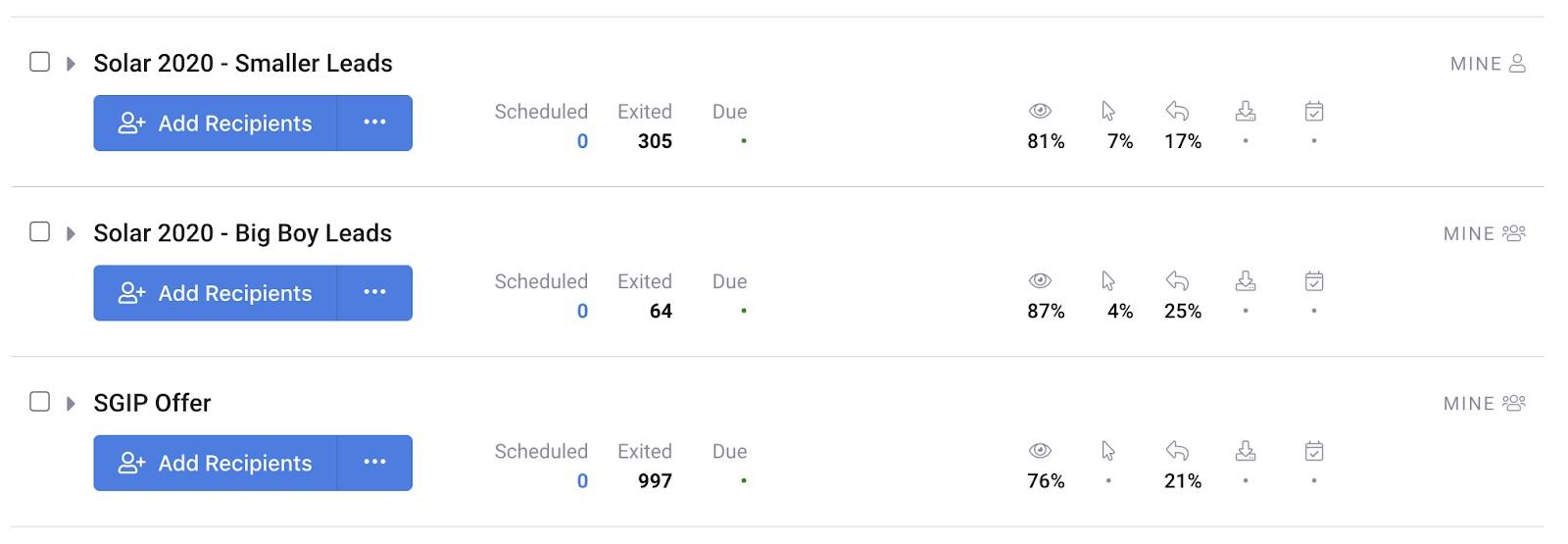
And 16-24% reply rates.

To do cold outreach effectively, both messaging and targeting are crucial. In this post, we’ll break down the list-building strategy and the messaging we used to acquire qualified leads.
Let's get into it.
%(tableofcontents)
Who This Post Is For
First off, this post is the opposite of “One Weird Marketing Hack: Guaranteed to Skyrocket Your Conversions!” Implementing a pain-based cold email strategy takes some work to set up.
This strategy requires time, attention, and energy to execute.
Sending cold outbound campaigns based on pain is not a marketing tactic; it’s sales. Your product needs to be priced at $10,000 to $50,000 or more a year to make this investment worth it.
If you're selling a $100-a-month thing, this is probably not the right strategy for you.
We see many clients who want to get it done right away, i.e., “I just want to ship! I want to ship!” and that's a laudable goal, but this is really about doing solid research.
Building personalized cold mail campaigns is like baking a cake. It can take a lifetime to master, but it’s something anyone can become proficient at if they put in the time and go slow at first.
With both baking and funnels, you’ll have the best results if you take your time in the beginning and stick to the recipe.
And if you’re baking a cake for someone else, it helps to know their likes and dislikes. In the next section, we’ll dig into personalization for outbound cold email campaigns.
Specificity Creates Powerful Marketing
Most B2B cold email campaigns rely on a buyer persona to generate a broad enough email to get the recipient to respond.
The result? Emails destined for the spam folder 🙁
Many of these emails even incorporate some basic personalization, such as a prospect’s first name and company in the email, as if that’s enough due diligence to engage the prospect and get them into the funnel.
Here’s an example from Brandon B. at Seamless AI.
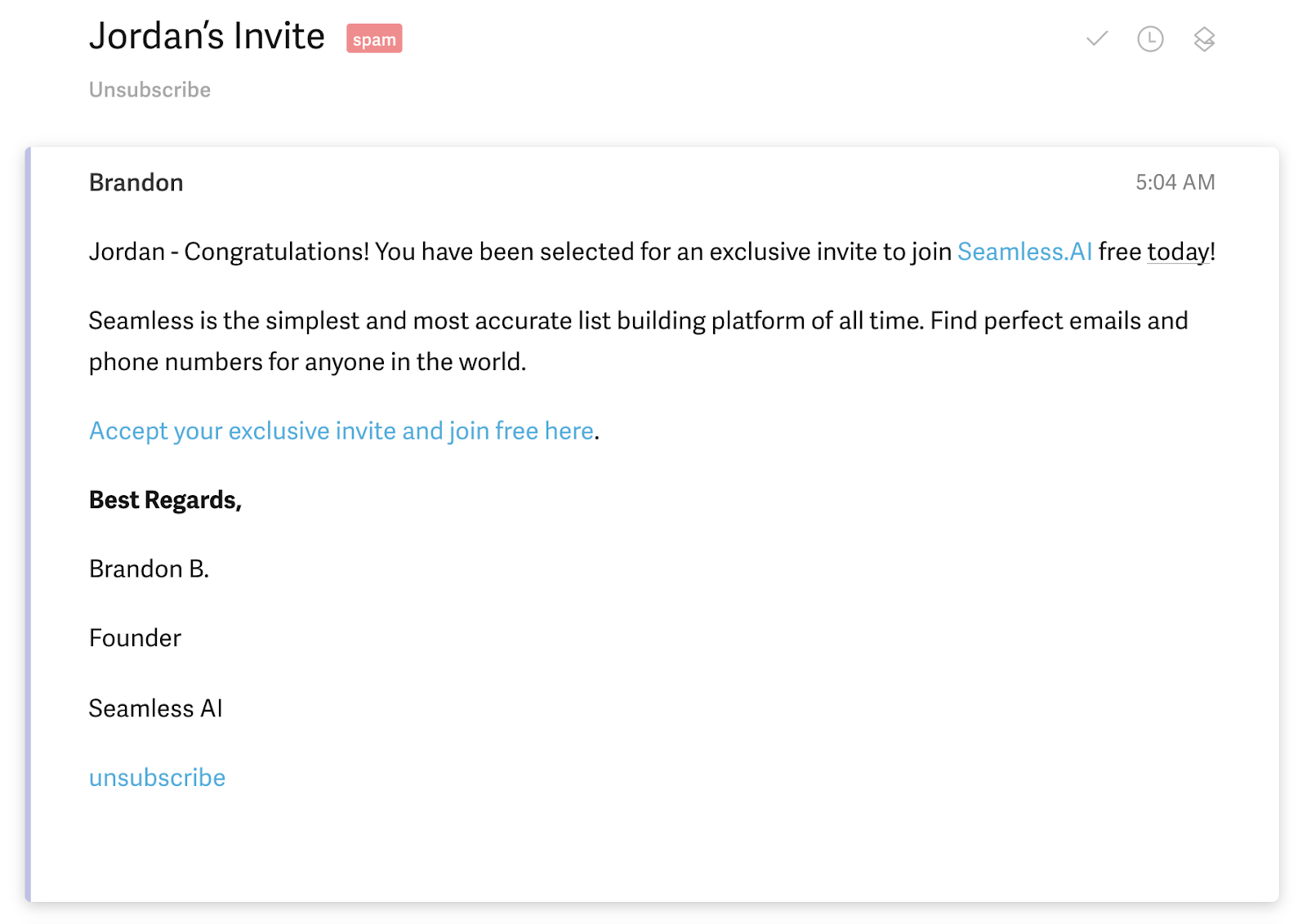
We pulled this email from the spam folder. And, boy, does this company spam.
[ASIDE: This is MARKETING, not SALES. Brandon should do this in an ad network. Sales emails are those where your primary goal is a reply and then a conversion, not a conversion—like Brandon is expecting,]
We’re not looking to single out Brandon B. here; everyone has a sent cold email like this (Scout included)!
We actually sent one like this just a couple of days ago because we tried to skip the process (it doesn't work).
Never forget that specificity creates powerful marketing.
Learn from our mistakes — don't send “dumb” cold email, and by that, we mean email campaigns that do not take advantage of publicly available data.
First, let’s talk about…
Why This Cold Email Sucks
To understand why this email gets sent to spam, it's important to understand the state of cold email today.
Google is one of many email providers, but their guidelines give us good best practices for sending cold email campaigns.
For a deeper dive on email deliverability, AppSumo’s post is highly recommended.
First, if Google calls your message “spam,” it’s spam. For better or worse, they are the judge, jury, and executioner here.
Luckily for us, Google posts clear guidelines on what is, and is not, spam.
Sure, this message is addressed to “Jordan” in the body, but that doesn’t mean it’s not spam.
The email is personalized, but it’s not personal. So, not only does this message go to spam, but it also doesn’t speak to any of Jordan’s specific needs, desires, or pain points.
If we want to engage with prospective customers, we need to tell them something important about themselves, or their company’s position in a certain market.
You may beg to differ and say, “Well, Jordan was selected for an exclusive offer here,” but the email does not say this offer is unique in any way to Jordan. Since Google marked this message as spam, that's a pretty good indicator it’s not exclusive.
Lastly, if your company sends emails that go to spam, this affects the deliverability of future emails. It’s likely that more of your emails will go to spam or bounce in the future.
By sending spammy emails, you are nuking your “sender reputation.” Your sender reputation determines the “trustability” of your email server, and the recipient’s email server uses this when deciding whether to put your cold outbound message in the junk folder. Having a low sender reputation doesn’t make your brand look great, either.
Email deliverability is its own dark art, so we’ll just leave it at sending spam is no longer an actionable strategy and can adversely affect your use of email as a channel.
Don’t Treat Your Prospect’s Email Like an Ad Platform
Brandon's cardinal sin here is he is doing marketing, not sales, in this email.
He’s treating Jordan’s inbox like an ad platform, like Facebook or LinkedIn.
This is a typical approach to email for most companies doing B2B email marketing — send tens of thousands of emails and hope someone bites.
It just doesn’t work like that anymore.
Email marketing will always be a numbers game, but now it’s not a numbers game where you can afford to be careless.
Targeting > Perfect Copy

See this guy? Let’s call him “Mr. Purple Shirt.”
If we said to Mr. Purple Shirt, “Hey, we have a pill that will help you with your stomach pains right away,” it doesn't matter exactly what words we say or what copy we use — if we’re talking about his pain and we’re addressing it to the right audience, he's gonna respond.
Targeting is so much more important than writing the perfect copy.
Generally, if you get the targeting right, you can actually talk about the targeting that you did in your email. We’ll share some examples later in the post, but let’s stay high-level for now.
The good news? There is a ton of easily accessible customer data online, and you can use this data to target your ideal prospects. With Facebook’s Ad Library, you can see the ads a company is running.
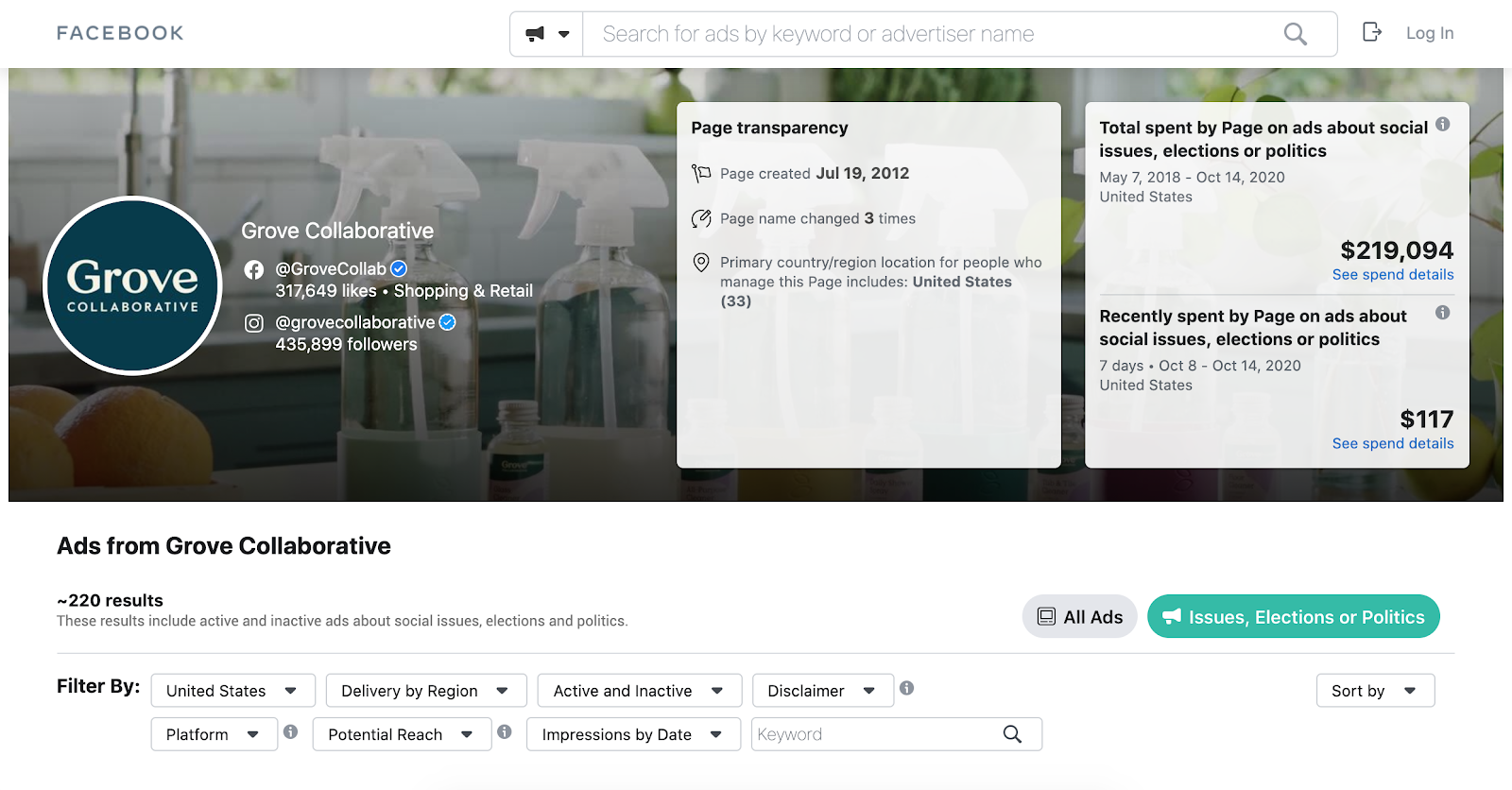
SimilarWeb shows what percentage of a company’s website traffic comes from where (i.e., search, direct, emails, etc.), and the money it spends on display ads.

These are just two examples, but the data to understand the context of your customer exists, and it’s public and sometimes even free.
Next, we’ll talk about how we used this data to create a personalized cold outbound campaign for Primer, an AI company.
Case Study #1: Primer
To help Primer, we first needed to understand what makes them special. One of their key differentiators is that they can target ads to specific people. Instead of the traditional method of targeting an audience, they can advertise to Larry, Maria, and Brenda, or to everyone who works at a particular company.
The problem is that a lot of these standard targeting solutions on Facebook or LinkedIn allow you to target only generic audiences. For instance, you can search for “IT professionals who work at companies with 1000-5000 employees, in the Boston metropolitan area.”
As far as targeting goes, this leaves a lot to be desired. LinkedIn, a leading lead-generation platform, often returns results that you don’t want, whether it’s leads who live abroad, have transitioned jobs recently, or are not in a position to make purchasing decisions.
Primer’s value proposition is that they solve the problem of building a better targeted list for prospecting. Their software then enables their customers to serve ads across platforms such as Facebook and LinkedIn.
Our Hypothesis
Our basic hypothesis was that customers “in pain” are much more receptive to solutions tailored specifically to solving their pain, as opposed to the more vague, persona-based marketing campaign approach. We also believed that we could find data that indicates a potential prospect in pain. We did this manually, and once we created the workflow, outsourced the research tasks to a virtual assistant.
To identify potential customers for Primer, we needed a set of criteria to qualify them. In other words, we needed to come up with indicators that signaled them as having a “pain” (ineffective advertising) that Primer could solve.
Here are two easily repeatable methods we used to find qualified leads by pain.
Part One: Quantifying Pain By Display Ads
In working with Primer, we first needed to quantify potential customers for them that are “in pain.”
“In pain” can be defined as having a quantifiable problem that has a real dollar cost. Often, companies are not aware of their main pain, and usually, a company has numerous pain points. Solving a company’s main pain point is a core tenet of solution-based selling, which has been around since the 1980s.
First, we looked at companies like Demandbase and Terminus, which sell account-based marketing (ABM) tools.
We formed a hypothesis that targeting these ABM companies might work, because many people were working from home due to the COVID-19 pandemic. We reasoned that since many office workers are spending most of their time at home, they were also being marketed to at home, not only as consumers, but via B2B as well.
It made sense that companies might modify their sales methods to become more personal, rather than blasting prospects with marketing materials via generic direct mail and email campaigns. We set out to test this hypothesis with highly personalized cold outbound email.
In our own day-to-day chats with customers and partners, we’d noticed that many companies had stopped running digital ads, and IP-based targeting wasn’t working for most companies either.
There was a trend of “wait and see,” and most companies we spoke to hoped social distancing would last no longer than a couple of months.
Some companies still ran a ton of online ads. Each company reacted to the pandemic differently.
We started to research the companies running ads on LinkedIn and Facebook. If a company wasn’t running display ads, we disqualified them as a potential lead for Primer.
(Note: As of 11/25/2020, LinkedIn has since discontinued the ability to see the paid ads a company is running via the company’s main page.)
For instance, although Peerspace, an event space rental platform, might otherwise be a great client for Primer, they weren’t running ads on LinkedIn at the time — likely because no one was renting event space.
We also looked at Atlassian as a potential lead for Primer.
We looked at Facebook’s Ad Library and saw that Atlassian was running ads on Facebook and LinkedIn — check.
To further qualify them as a potential lead for Primer, we needed to identify if their ads were being served to the wrong people.
We took a simple approach, examining the comments on many of their LinkedIn ads. A lot of them turned out to be spam, or from accounts that didn’t appear to be in their target market of the United States.
Here’s one example:

Basically, Atlassian was paying LinkedIn for spam, and throwing away their ad dollars.
This indicated the existence of a significant pain for Atlassian. Atlassian may or may not have been aware of this pain, but, based on these criteria, they looked to be a qualified lead for Primer.
Part Two: Quantifying Pain By Ad Spend
To further validate our hypothesis, we used SimilarWeb to look up traffic for potential leads and find the domain’s traffic sources.
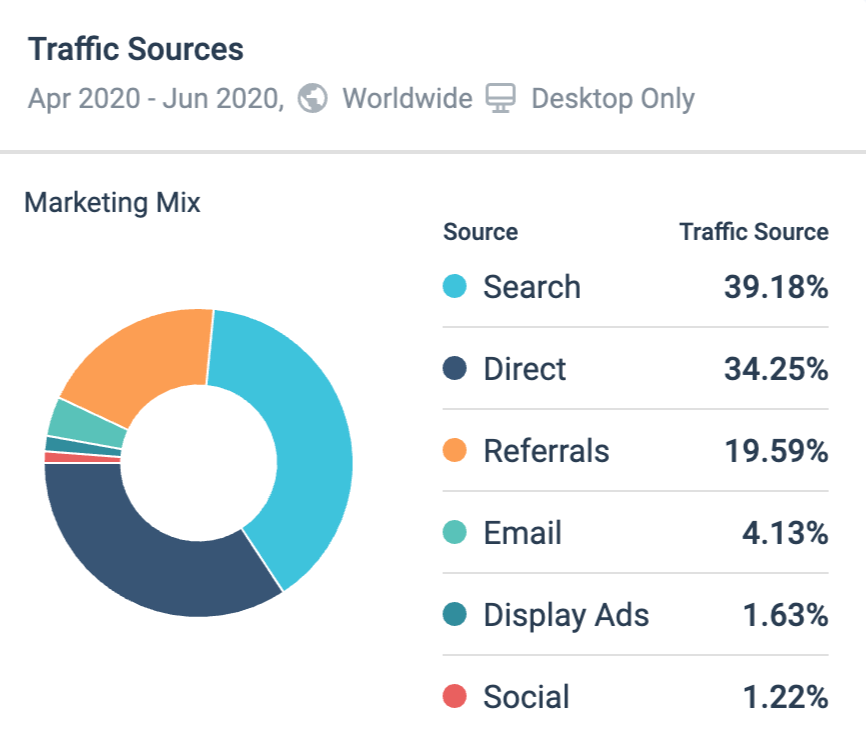
From here, we researched pay-per-click costs for some target keywords, and found the cost to be between $0.79-0.97, depending on the source.
We then took the traffic that comes from programmatic display ads to figure out how much Atlassian spends per month on digital ads.
This is incredible data to use in creating copy for email campaigns to this client (and at scale). For instance, if Atlassian spends $200,000/month on digital ads, and we can improve their conversion rate by 5-10% through more accurate targeting, that’s up to $20,000 dollar savings for them due to the improved targeting offered by Primer.
In other words, it supercharges the offer in our email copy, making it a no-brainer for them to at least try Primer to see if it works.
Next, let’s get into how to apply our research to the email copy for cold outbound.
The Email Message: Primer
Here’s the email we use. Scout uses variations of this message to get 80-90% open rates and 16-24% reply rates.
Two of the most important points here are:
-
Tailor the message to your list.
-
Test, test, test. Depending on your list size, segment the list and a/b test different pieces of copy.
Here’s the email in full.
Subject line: Is {{company}} open to experiments?
Body:
Hi {{first_name}},
Looking through {{company}}’s presence, I noticed that some of your recent ads aren’t getting the right kind of engagement. Specifically, I saw {{commenter_name}} – {{commenter_title}} in {{commenter_country}} engage, and they didn’t seem like a good lead for you. Based on some analysis from SimilarWeb, it looks like you’re spending at least {{ad_spend_amount}} on display ads. This is why I’m reaching out.
If you could be 100% certain that only companies like {{reference_customer}} would see your ads, would you be open to experimenting?
I’m Keith, the CEO of Primer.
CPMs (the price for a thousand ad impressions) are down 20% – so it’s a good time to experiment. In short, if you spend $2,500 today, you’ll get $7500 worth of exposure.
When Rippling(W18) used Primer, they went from a 2% to a 5% demo rate by targeting ads only to specific leads.
If you could know that your ads only target companies like {{reference_customer}}, would that be interesting to you?
{{email_signature}}
P.S. We can also help you find a consultant in our trusted growth network to execute the ads for {{company}}.
It’s important to note that each of the bracketed text represents a variable that can be called in your email software of choice (we use Mixmax). To scale this, you simply feed your email software a spreadsheet with the appropriate columns, and it will pull personalized data for each email.
Next, we’ll break this message down, line by line.
Subject Line
We used the subject line, “Is {{company}} open to experiments?”
By examining Atlassian’s paid ads, CPC for their target keywords, site traffic, and display ad spend, we can say with confidence that they appear to be open to trying new marketing experiments. After all, aren’t all ads, and marketing campaigns in general, experiments in their own right? (Yes, the answer is “yes.”)
We’ve tested this headline. It gets good open rates because the message is vague enough to make you want to open versus trying to “sell” in the subject line.
Adding the company name in the subject line is basic, best practice email personalization.
Body
We’ve put the contact’s name in the first line of the email as well — more basic personalization.
Hi {{first_name}},
Now here’s where the rest of the email basically writes itself, based on the research we’ve done.
Looking through {{company}}’s presence, I noticed that some of your recent ads aren’t getting the right kind of engagement. Specifically, I saw {{commenter_name}} – {{commenter_title}} in {{commenter_country}} engage, and they didn’t seem like a good lead for you. Based on some analysis from SimilarWeb, it looks like you’re spending at least {{ad_spend_amount}} on display ads. This is why I’m reaching out.
Here, we’ve crystallized a pain that they may not even know they had. By framing how much they’re spending on ads in this way, we quantify the size of that pain.
We then give them the offer. We can task a virtual assistant to pull the data for an exact reference customer.
If you could be 100% certain that only companies like {{reference_customer}} would see your ads, would you be open to experimenting?
At this point in the email, we need to introduce ourselves. We do, but keep it short and sweet. Let’s let our results do the talking here.
I’m Keith, the CEO of Primer.
Next, we give a reason to act and demonstrate what Primer can do for them. It’s important to note that your potential customer has every reason in the world not to act. We need to provide an offer that’s compelling enough for them to try our service.
CPMs (the price for a thousand ad impressions) are down 20% – so it’s a good time to experiment. In short, if you spend $2,500 today, you’ll get $7500 worth of exposure.
When Rippling(W18) used Primer, they went from a 2% to a 5% demo rate by targeting ads only to specific leads.
We close out the email with a strong “yes/no” question that reframes our offer as a no-brainer.
If you could know that your ads only target companies like {{reference_customer}}, would that be interesting to you?
Lastly, we include a P.S. offering to help them if they are open to looking at other ad agencies.
P.S. We can also help you find a consultant in our trusted growth network to execute the ads for {{company}}.
Case Study #2: Pico
Pico helps you monetize your online community. They streamline email capture, user sign-up, and payments. Pico creates a journey for users to join your community and to support your work financially.
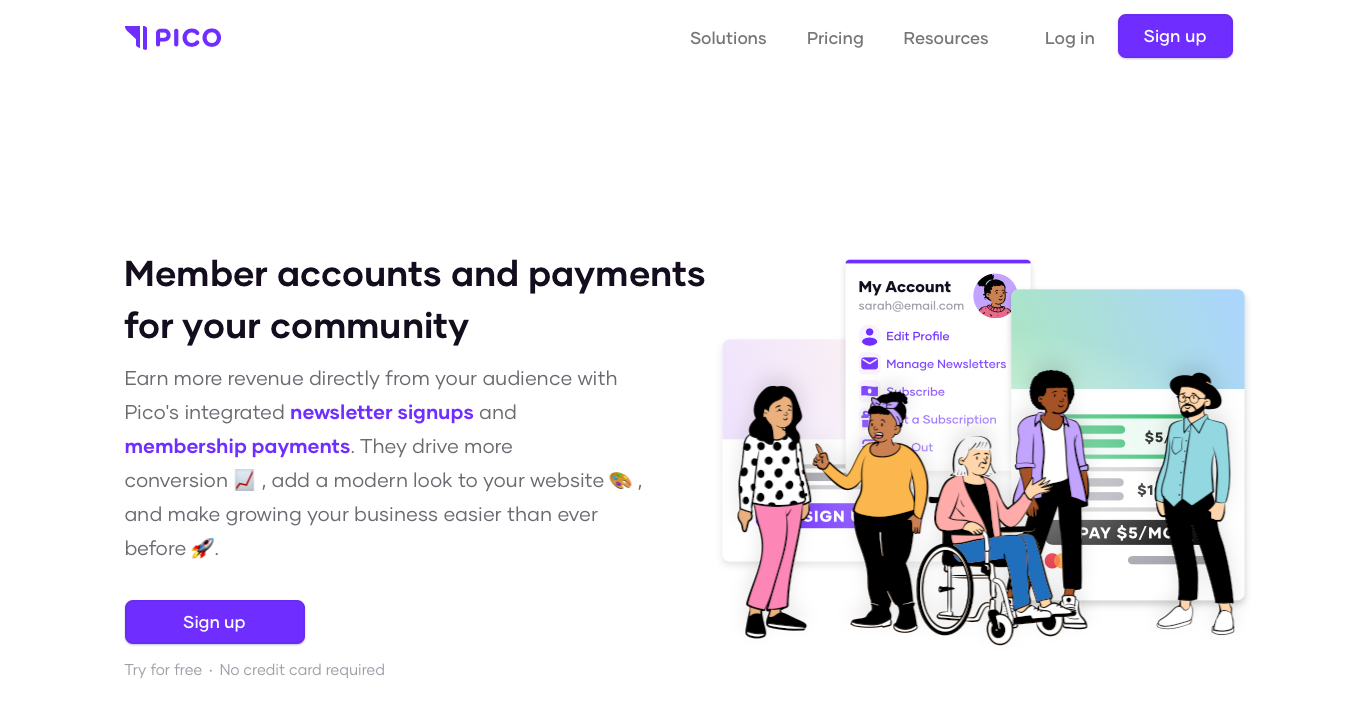
It’s also no-code and integrates easily with WordPress and other hosting platforms.
For Pico, we identified yoga studios as a potential audience to target.
Why? With social distancing, most studios were forced to close or to take their classes online.
That may sound simple enough — just use Zoom and throw up a PayPal link — and some yoga studios did just that.
There were also a lot of yoga studios that were closed, at least temporarily.
Quantifying the Pain: Yoga Edition
So, how did we quantify the pain for yoga studios?
We started with Yelp.
It turns out that some yoga studios already have virtual classes, which is to be expected. These studios might even still be a lead, as they may have trouble collecting email sign-ups and payments. For now, we need a stronger indicator of pain; we’ll disqualify them.
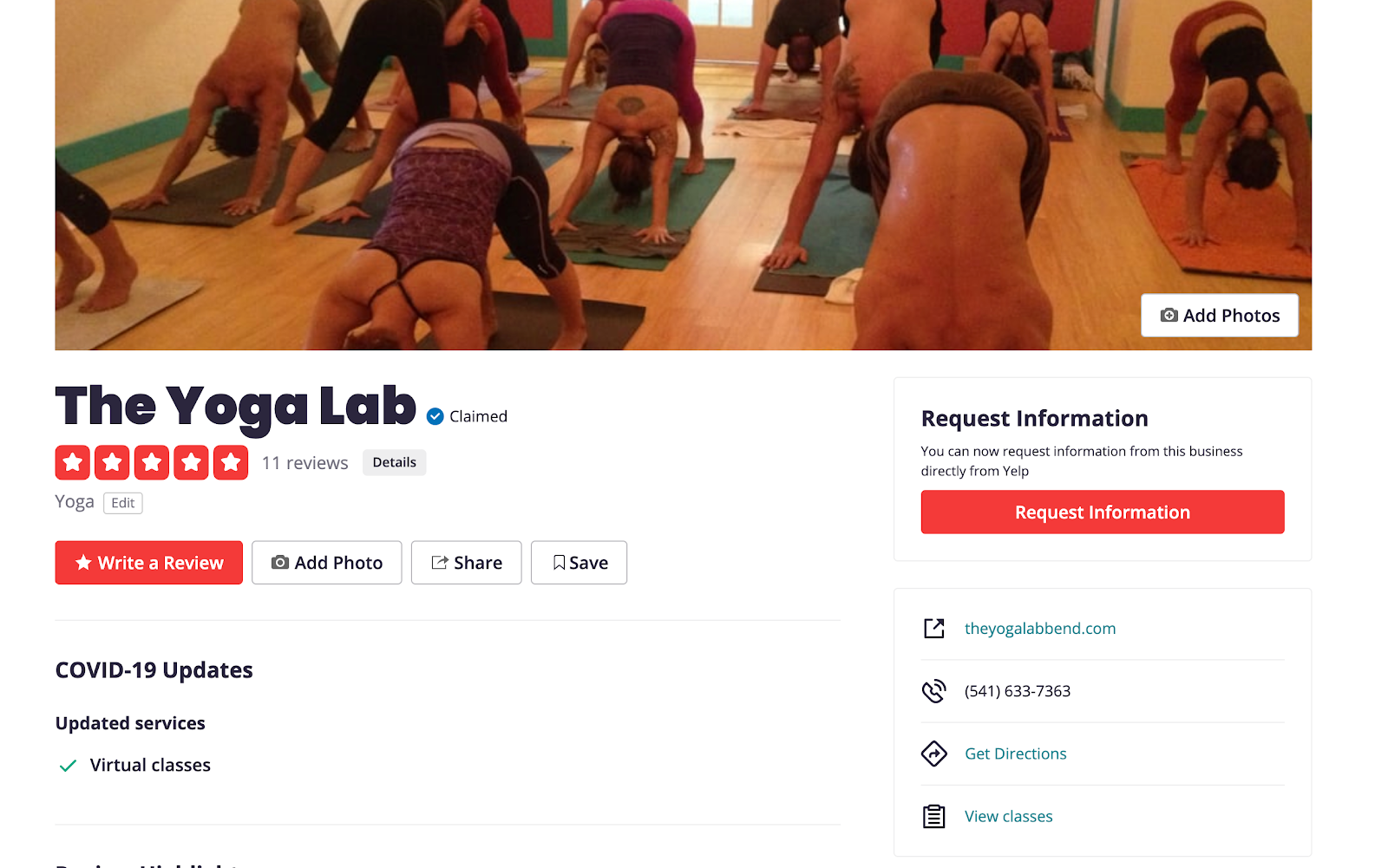
In searching Yelp, we also found many yoga studios that weren’t offering online classes yet.

For those studios, Yelp had a generic message about COVID-19, and to “please contact the studio” directly.
We then used an advanced Google search with these criteria to find yoga studios that might be a fit.
Our search criteria included:
-
Pages with the word “yoga”
-
Pages without the phrase “virtual classes”
-
Only search pages on the yelp.com domain
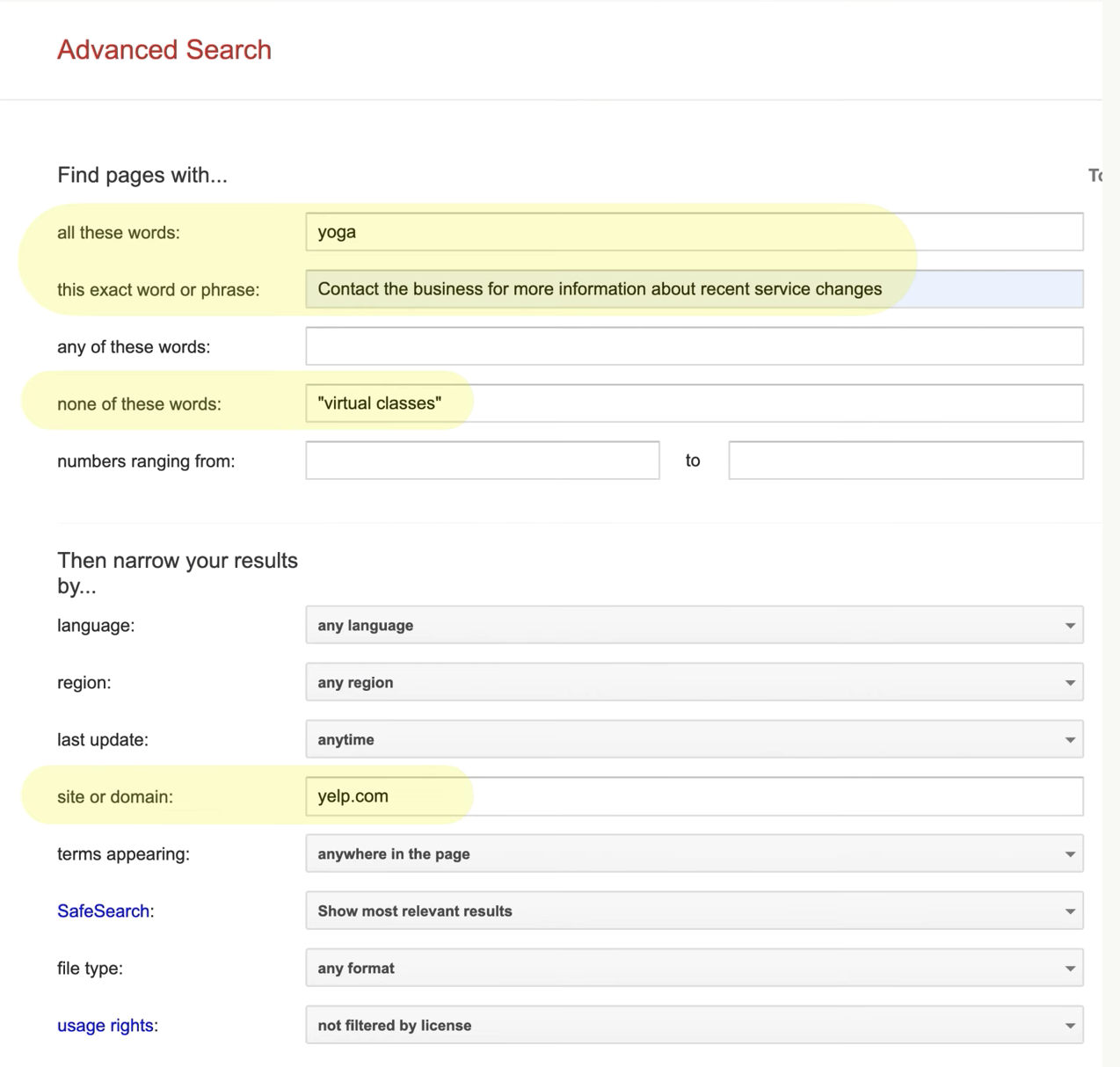
The search results returned 105,000 possible businesses that had not updated their Yelp message and, most importantly, were likely not currently offering virtual classes. We began to check through the results manually.
For instance, we looked at the third result, for Leigh Ferrara yoga. There was a link to a classes page, but the page wasn’t found.
This broken page link indicates a pain. This further qualifies this business as someone Pico can help.
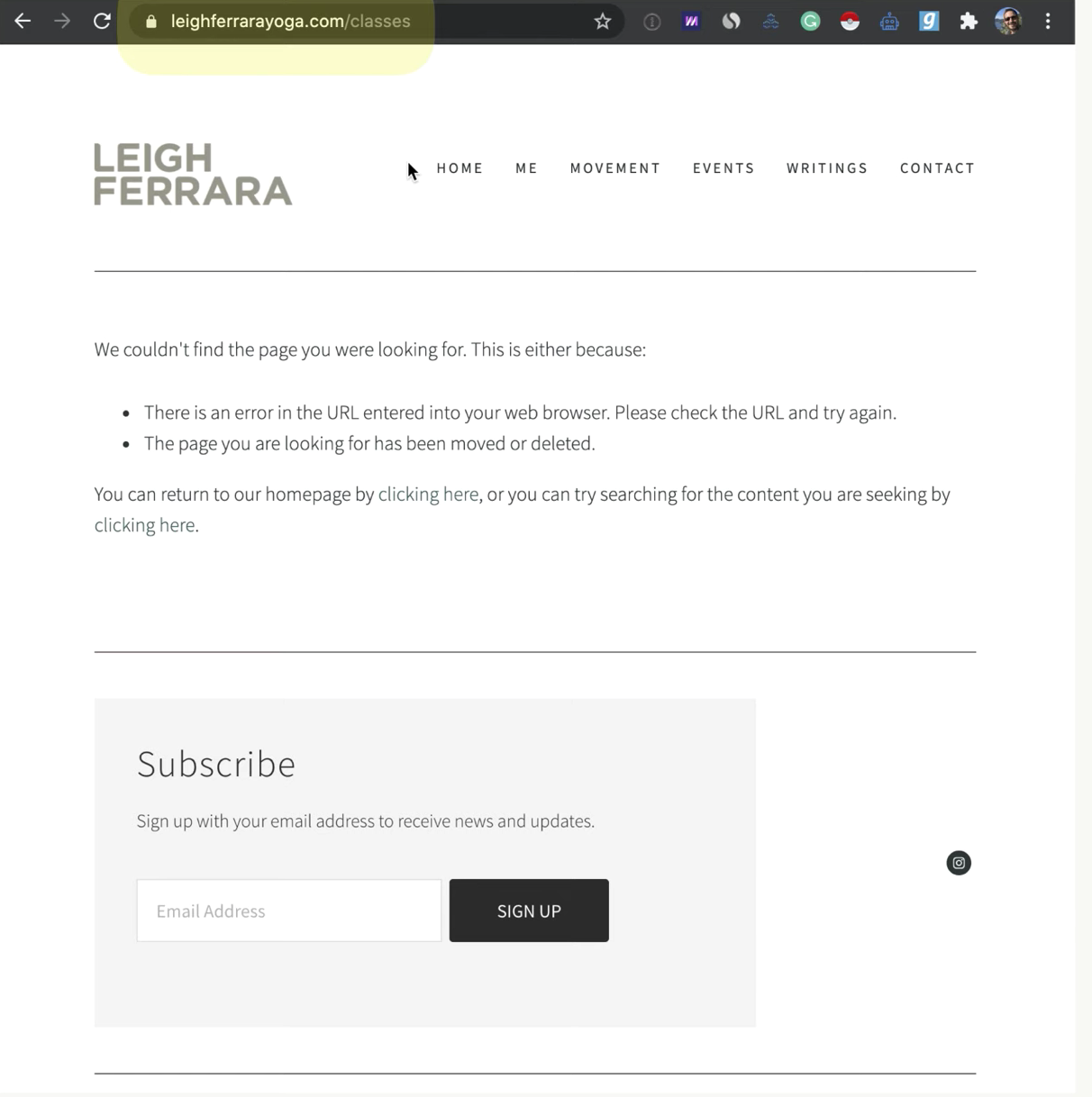
Next, we hired a virtual assistant to create a spreadsheet of studios with these criteria — basically, “yoga studios not currently offering online classes via Yelp or their business’ website.”
We found the yoga practitioners’ emails then crafted our cold outbound email to address their specific pain points.
The Email Message: Pico
Here’s the complete message. Essentially the same song and dance as the email we wrote for Primer, but with a few key differences.
Subject line: Paying for {{studio}} classes
Body:
Hi {{first_name}},
Saw that {{studio}} has moved to online classes but isn’t collecting payments online yet.
My name is Jason and I run Pico.
When Laura’s Vinyasa moved her studio online to Pico, the last thing she wanted to think about was the technology to manage her classes online. After only four weeks, her business is now making more money than when she was running a physical studio, and the only thing she had to do was give us access to her website.
Is collecting payments a current challenge?
{{email_signature}}
Subject Line
We kept it simple here, addressing the pain point and adding the studio name in the subject line.
Body
We always start with the reason. Your prospect needs to know why they are receiving an email from a stranger. Keep it simple and casual.
Tell your prospect why you’re reaching out. Your prospect wants to know what makes them special, or what is unique about themselves, so we tell them in the first line.
Saw that {{studio}} has moved to online classes but isn’t collecting payments online yet.
Next, we briefly introduce ourselves, and then use social proof to show what we can do for our prospect.
We talk about Laura’s Vinyasa’s story, and the results she achieved since switching to Pico.
My name is Jason and I run Pico.
When Laura’s Vinyasa moved her studio online to Pico, the last thing she wanted to think about was the technology to manage her classes online. After only four weeks, her business is now making more money than when she was running a physical studio, and the only thing she had to do was give us access to her website.
Lastly, instead of pushing for a demo call or a meeting, we allow the prospect to “qualify themselves,” and we ask them a simple yes or no question in the email. If the answer is “yes,” it’s likely that they will continue the conversation, and possibly become a customer.
Is collecting payments a current challenge?
We want to verify that collecting payments is a challenge for the studio owner first, and then we can take it from there.
Case Study #3: Scout
For the third case study, we’ll talk about how we do cold email campaigns at Scout.
At Scout, we send hyper-customized, trackable postcards. We set up custom landing pages, so leads can go straight from a postcard to a personalized landing page, and use public datasets like Google’s Project Sunroof to identify potential savings if a homeowner installs solar.
This year we’ve been targeting solar installer companies in California. One of their major pains is they can’t use knocking on doors as a marketing channel because of the COVID-19 restrictions.
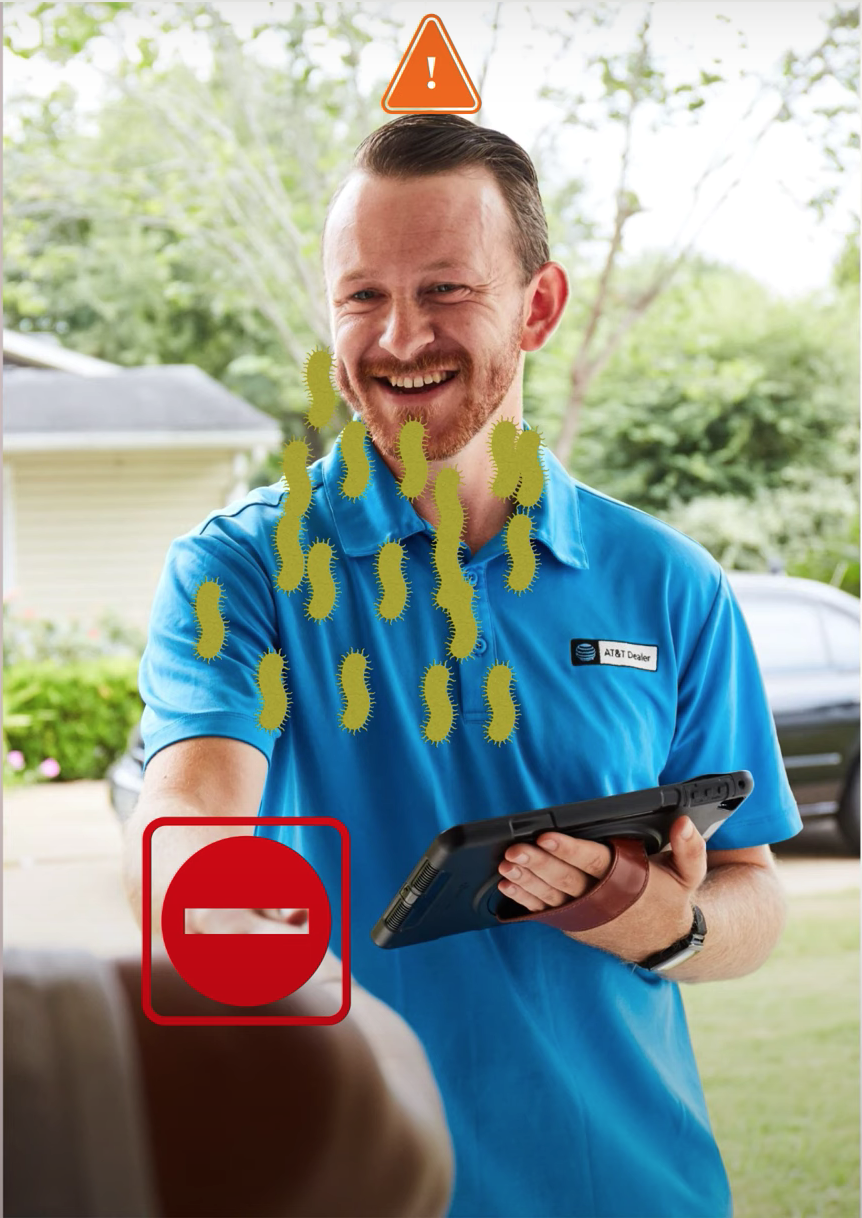
Homeowners are scared, and rightfully so.
For solar installers, it’s devastating. Door-knocking was one of their main channels, and it produced a massive amount of ROI for them.
For Scout, this was an opportunity to approach these solar installers and offer them personalized direct mail postcards to replace door-knocking as a marketing channel.
We can replicate a lot of the same lead tactics that solar installers did with door-to-door by targeting the six nearest neighbors of existing installs.
Here’s an example of how Scout offers postcard marketing to solar installers.

Essentially, we can use this nearest neighbor strategy to tell solar prospects, “Hey, I was just over at Larry's house and Larry used us to install solar panels. I wanted to let you know that he had a good experience. Here’s how much you can save. You should chat with him about what it’s like to go solar.”
In this instance, door-to-door is totally something you can replicate with postcards.
We also included a picture of their roof from space, and included variables about how many hours of sunlight per year they get.
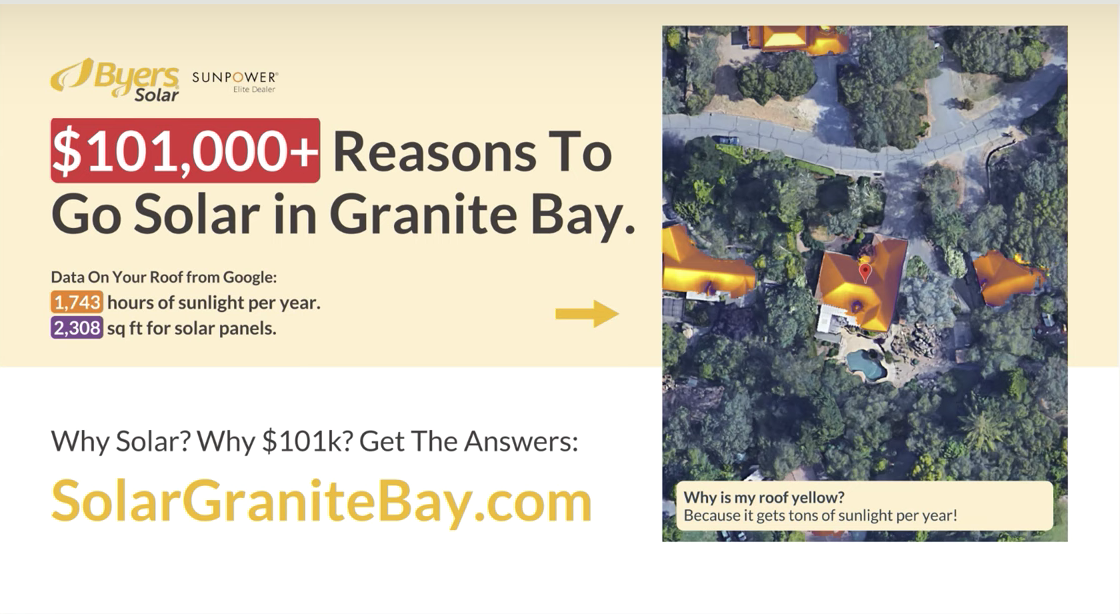
We hired an outsourcer to look at every roof from space and record either “has solar” or “doesn’t have solar” to exclude residences with solar as leads.
Quantifying the Pain: Solar Installers
So, how do we quantify the pain for homeowners so we can help solar installers engage them as customers?
It turns out there's a fantastic dataset for this purpose on California’s Net Energy Metering program. This is a list of every solar installer and every installation of solar panels in California. From this data, we can tell exactly how successful solar companies are, and see who has historically sold a lot of solar installations. We can also identify, by sales data, which of these companies are in pain right now, and might be open to running a direct mail test.
The Email Message: Solar
Here’s the complete message:
Subject: Are tigers roaming around {{company}}’s hq?
Body:
Hi {{first_name}},
{{company}} came across my radar when looking through CA NEW data. You were the #1 installer in {{1_zip_count}} zip codes by total system cost in 2019! Your best zip code was {{1_zip}} – does that sound about right? This is why I’m reaching out.
I’m Jordan and I run sendwithscout.com. We achieved a 2x ROI for Mauzy Solar in Santee, CA, with postcards targeting high-value areas. There’s also a few other novel direct mail approaches that I’ve seen work really well that I’d be happy to chat about.
I don’t have any expectations that you’re doing heavy marketing right now, but I know that a ton of solar companies depend on door-knocking tactics, and, obviously, that’s not possible right now.
Let me know if you’d be open to exploring. If not, we totally understand the need to cut back.
How interesting does this sound to you?
{{email_signature}}
Subject Line
Thanks to Tarik Sehovic for this high-open-rate subject line. Tiger King was popular when we were using this, and it did really well – an 89% open rate!
Body
We targeted solar installers that had a great year in 2019 and had declining sales in 2020.
Hi {{first_name}},
{{company}} came across my radar when looking through CA NEW data. You were the #1 installer in {{1_zip_count}} zip codes by total system cost in 2019! Your best zip code was {{1_zip}} – does that sound about right? This is why I’m reaching out.
This email had a 26% open rate because we told each solar installer something about their business that they did not already know.
Basically, we told them, “Did you know, across the entire state of California, you’re the leading installer in these 10 zip codes? And by the way, your best zip code was 94109.”
In speaking with solar installers, we often get the question, “how did you know this?”, and the installers are often surprised we have this data.
Next, we introduce ourselves, talk about the results, and remove some of the selling pressure.
I’m Jordan and I run sendwithscout.com. We achieved a 2x ROI for Mauzy Solar in Santee, CA, with postcards targeting high-value areas. There’s also a few other novel direct mail approaches that I’ve seen work really well that I’d be happy to chat about.
I don’t have any expectations that you’re doing heavy marketing right now, but I know that a ton of solar companies depend on door-knocking tactics, and, obviously, that’s not possible right now.
This was important because some counties in California froze issuing solar install permits, so we want them to know we’re aware of the challenges they’re facing.
We also remind them about losing their favorite channel — door-knocking — to better position our offering as the solution.
To round out the email, we have the qualifying question and the signature, same as the previous two emails for Primer and Pico.
Let me know if you’d be open to exploring. If not, we totally understand the need to cut back.
How interesting does this sound to you?
{{email_signature}}
Doing It At Scale
One thing we’ve yet to touch on is how to do this to send 5,000, or 10,000, or 100,000 unique emails.
First, break down what you do into discrete tasks that don't need external explanation and can be answered by simple yes/no questions. You’ll need to hire a virtual assistant and then train them on this task.
Training a virtual assistant on the task is much more detailed than saying, “Hey, look at this solar installer’s webpage and see if they’d be a great lead for selling them a direct mail campaign.”
You need to give them precise instructions on collecting the data you need to qualify prospects.
One way to do this is to record a Loom video of yourself doing the task and talking through it, manually collecting the data for 10 or 20 rows, or at least until it seems clear enough how the task needs to be done. If it’s not already clear, this is the data your automated outbound campaign will pull into each email you send to prospects.
You might tell them:
- Look at this solar installer’s website. Does it contain the word products?
- Does this lead have the phrase “direct mail” in their LinkedIn summary?
And so on.
We recommend doing the first 20 or 30 rows yourself to get a thorough understanding of the task and then recording the Loom video for the virtual assistant. By spending an hour or so doing the task, you’ll usually come across enough context to explain the task to your VA.
Finding the Right VA
It’s also wise to hire multiple VAs at first and give them all pieces of the same task so that you can evaluate and ultimately select the best one.
We recommend hiring a minimum of 10-20 VAs for an “evaluation task” to find one or two good ones. Filling in the data for 100 rows is a good initial task to evaluate if they’re worth working with.
Once you’ve found a VA that you’d like to work with, pay them by the hour and not by the row.
To pay them hourly is more expensive at first, but ultimately, once you train someone and you’re working with them consistently, they will help you achieve way more than if you hired an agency or did these tasks yourself. We find that it’s easier for both parties to allow the VA to charge by the hour.
This builds trust with your VA over time, rather than nickel-and-diming over the number of rows completed.
You can find VAs via sites like Fiverr, Gigster, or onlinejobs.ph. Amazon’s Mechanical Turk is also good for super simple tasks, like disqualifying solar roofs.
For instance, we had three different Mechanical Turk workers disqualifying solar roofs. We asked them to look at each roof from space and mark a simple yes or no to the question, “does this home have solar panels?”
Go Forth
So you read this 5,000-word post, and you’re an expert now at creating pain-based cold outbound campaigns at scale. Now go do it!
If you have any questions about what we covered here, give us a shout. We love this stuff!
Jordan Crawford is the Founder/CEO at Scout. In his spare time, he enjoys nature and a good cup of cappuccino.
Alex Wagner co-authored this post. He runs Growth and Accounts at Scout, and wants you to know that he still skateboards at age 34.
Add A Comment
VIEW THE COMMENTS